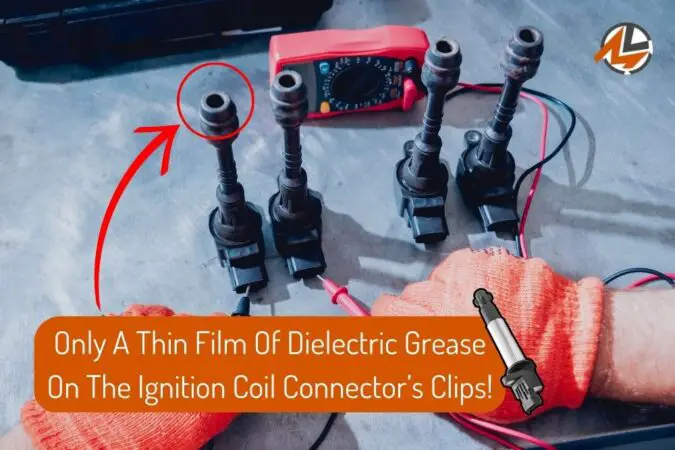One of the most underrated yet important bits of kit in my garage is a small tub of dielectric grease. There’s a myriad of uses and applications for dielectric grease, but where should you put it on the ignition coil?
Dielectric grease is a non-conductive, silicone-based grease that’s designed to seal out moisture and prevent corrosion on electrical connections, and on the ignition coil, it’s applied on the clips at the end of the coil.
However, when applying dielectric grease on the ignition coil connectors, be cautious to not have any of the dielectric grease be pressed onto the electrical contacts themselves. And, only use a thin film of grease.
- What Is Dielectric Grease?
- Where To Use Dielectric Grease?
- How To Apply Dielectric Grease?
- Common Mistakes To Avoid
Dielectric Grease
So, why do you even use dielectric grease on your car’s coil pack? When it comes to ignition coils, the main purpose of using dielectric grease on the ignition coils is to protect the coil contacts from moisture.
Moisture can lead to corrosion on the ignition coil contacts, which can cause the coils to malfunction. That can result in reduced spark efficiency or misfiring at inappropriate times, leading to engine stumbles.
Especially during cooler months, moisture build-up on the ignition coil pack can become more pronounced. This makes the use of dielectric grease even more crucial. Some mechanics even use it for the spark plugs.
However, when applying dielectric grease on the ignition coils, there are three things to consider: 1) where to apply the dielectric grease, 2) how to apply them, and 3) the most common mistakes to avoid.
Where To Use Dielectric Grease
Your car’s ignition coil has connectors that are often accompanied by small clips (these clips are where you put the grease). These connectors are the primary points where the dielectric grease should be applied.
Your ignition coil connectors are the primary interface between your ignition coil and the rest of your car’s ignition system, and this makes the electrical connections vulnerable to moisture and potential corrosion.
While it might seem counterintuitive, it’s crucial not to press the grease directly into the electrical contacts. The grease’s primary role is to act as a barrier against moisture, not to enhance electrical conductivity.
Introducing it directly into the contacts can disrupt the electrical flow. Therefore, make sure that you apply the dielectric grease only onto those small clips on the ignition coil’s connectors, and only use it sparingly.
How To Use Dielectric Grease
The right amount of dielectric grease can ensure protection from moisture without hindering the electrical connection of your ignition coils. As such, you should only aim to apply a thin film of grease on the clips.
Think of it as a protective layer rather than a filler. When it’s over-applied, dielectric grease could act as an insulator. This can disrupt the ignition coil’s function. A thin film of dielectric grease is akin to a light smudge on a surface.
TIP:
Trying using a Q-tip. A Q-tip offers precision, allowing you to now apply the grease to specific areas without overdoing it. Its small tip ensures you don’t accidentally press grease into the electrical contacts.
For larger ignition coils or harder-to-reach areas, a small brush or even a gloved fingertip can be used. The key is to maintain control over the application. Once again, make sure to not put them over the contacts.
Mistakes To Avoid When Using Dielectric Grease
The most typical mistake made by a lot of folks that I come across is accidentally applying dielectric grease on both ends of the ignition wires, thinking that it would enhance conduction. This is a misconception.
Over-application can lead to rough idling or stalling. If your engine starts to stumble post-application or if you see a check engine light indicating an issue with the ignition coil, these are signs of over-application.
If that happens, it’s suggested to promptly remove the ignition wires. Next, clean off the excess grease, and then reapply a thin layer to the boot. Crucially, avoid the conductive metal/wire ends inside – as mentioned earlier.
As I’ve emphasized earlier, a thin film is all that’s needed. Over-application can lead to engine issues. Otherwise, you can use an electrical contact cleaner for thorough cleaning. The solvent will help dissolve and remove the grease without leaving a residue, especially if it’s gotten into the electrical contacts.


